All Management Events
- Dr N Satya Krishna October 4, 2022
- Mani Saketh’s exciting Marquee offer of CTC 21 LPA September 30, 2022
 Mani Saketh is beyond happy to get placed with a Marquee offer of CTC 21 LPA in his third year of under graduation at the Department of Computer Science and Engineering. He is placed at Western Digital, the company that introduced hard discs to the world. An immense commitment to obtain a Marquee offer was the driving force of his placement journey. He believed in keeping hope, persistence, and perfection alive at heart as they procreate the momentum to learn anything.
Mani Saketh is beyond happy to get placed with a Marquee offer of CTC 21 LPA in his third year of under graduation at the Department of Computer Science and Engineering. He is placed at Western Digital, the company that introduced hard discs to the world. An immense commitment to obtain a Marquee offer was the driving force of his placement journey. He believed in keeping hope, persistence, and perfection alive at heart as they procreate the momentum to learn anything.The company he got placed in basically works on HDD’s, SSD’s, Pendrive, NAND Flash-based Storage devices, etc. It is a hard disk drive manufacturer and data storage company. It is also the parent company of SanDisk. It was his internship that led him to this enormous placement offer.
He is in awe of the robust support system that the Directorate of Corporate Relations and Career Services is. “They helped me a lot by bringing many Marquee companies at the beginning, which made me work faster on my skills. The way they helped us by conducting various training sessions, responding very quickly whenever we have a single doubt or concern is commendable”, said Mani Saketh with most gratitude.
He was part of the Marquee Training Batch, where he got the freedom to practice whatever he wanted. But at the end of the day, all he wanted was to show some progress. Students who attended the Marquee training session used to solve coding questions, and if anyone failed to find the solutions, they had discussions in peer groups. This helped the students with the benefits of self-learning. The interactions among students during the problem-solving sessions encouraged their communication skills and improved their efficiency in resolving any coding question.
Mani Saketh thanked Mr Laxmanan Angu Raju, one of the senior managers of the Directorate of CR&CS, for having hope and confidence in him. According to him, getting placed at Western Digital wouldn’t be possible without the help of Ms Akhila, CR&CS executive. The mentoring and training of the placement team stayed with him throughout the placement session. He also thanked Dr Jaya Lakshmi Tangirala, his placement mentor, who made him realise the importance of CSE core fundamentals in the initial days of placement training.
As of now, Mani Saketh wants to convert this internship offer to a full-time offer and would like to work in the organisation for at least three years. Later, based on his interest, he wants to study further and grow in the company.
Continue reading → - Community training on CPR at SRM University- AP September 30, 2022
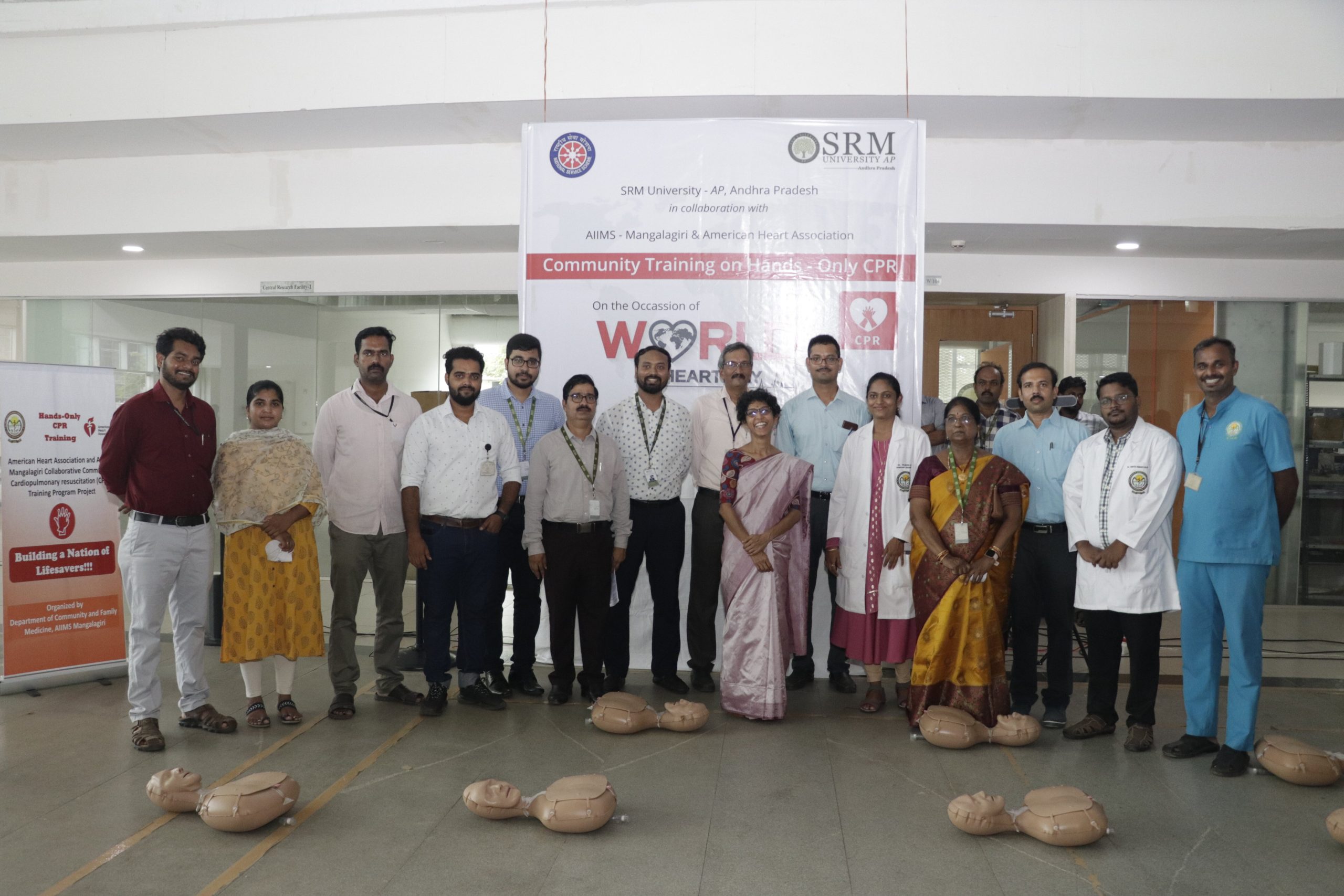
SRM University- AP in collaboration with AIIMS Mangalagiri and the American Heart Association, organised community training on CPR (Cardiopulmonary Resuscitation – Hands-only CPR) on World Heart Day – September 29, 2022. The training programme with the slogan ‘Your Hands Can Save The Lives’, was designed to generate perception on the significance of CPR in sustaining a life at a crucial medical instance. Dr C H Lakshmi Rajyam, Medical Officer, SRM AP addressed the gathering on the importance of heart health and CPR training.
Community Training on hands-only CPR held by the university aimed to educate participants on the essential skill of performing Hands-Only CPR to sustain life until advanced help arrives by artificially circulating oxygen to the brain. Trainers from AIIMS conducted the session through simulation mode with one mannequin per person. The methodology of proper implementation of CPR during an emergency was conveyed through a video-supported practical session.
The World Heart Day is celebrated on September 29 to create awareness on the importance of heart health and prevention and control of cardiovascular diseases (CVDs). CVDs is one of the leading causes of death claiming approximately 18.6 million lives every year globally. The theme for World Heart Day for 2022 is “Use Heart for Every Heart.”
World Heart Day celebrations at SRM AP promotes the idea of heart health as a fundamental human right and an essential component of global health justice.
Continue reading → - Two paper publications from Prof G S Vinod Kumar and his scholar September 29, 2022
A robust body of published works helps advance research capabilities and contribute to the larger research domain. Two latest paper publications from the Department of Mechanical Engineering are co-authored by Prof G S Vinod Kumar and his PhD student, Mr Akshay Devikar.
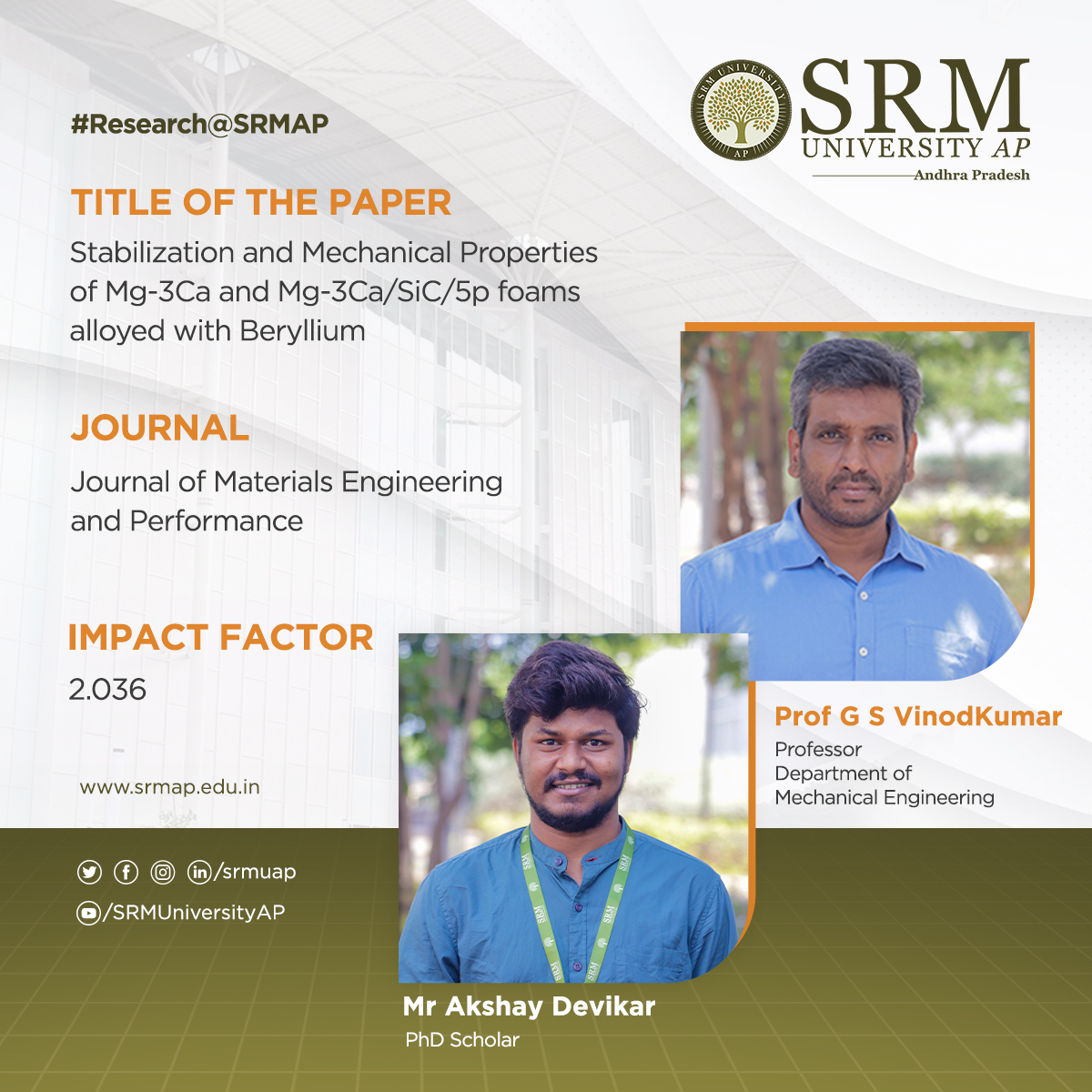 The first paper, Stabilization and Mechanical Properties of Mg-3Ca and Mg-3Ca/SiC/5p foams alloyed with Beryllium, got published in the Journal of Materials Engineering and Performance and had an impact factor of 2.036.
The first paper, Stabilization and Mechanical Properties of Mg-3Ca and Mg-3Ca/SiC/5p foams alloyed with Beryllium, got published in the Journal of Materials Engineering and Performance and had an impact factor of 2.036.Liquid processing of Magnesium is complicated due to its uncontrolled flammability in the presence of oxygen. However, owing to the lightweight property of Mg, it can be used as a structural material in various sectors such as naval, aerospace, automobile, biomedical, heat exchangers, and military applications. Therefore, using Ca and Be as alloying elements and oxidation preventers, the researchers produced lightweight Mg foams (of density 0.17 g/cm 3), which float on water. SiC particles provide excellent Mg foam stabilisation as well. The compression tests revealed the highest strength for Mg-3Ca foam containing both Be and SiC. Thus, the burning problem of Mg was overcome by adding Ca and a trace quantity of Be to make lightweight foams, which were strengthened by SiC particles.
Abstract
The present paper investigates the stabilisation of Mg-3Ca alloy and Mg-3Ca/SiC/5p composite foams with and without the addition of 0.12 wt.% beryllium. In Mg-3Ca alloy foam, Be addition has significantly improved the expansion and pore structure. Whereas, in the case of Mg-3Ca/SiC/5p composite foams, the SiC particles stabilised the foam effectively, while Be addition did not show any distinguishable improvement in the foam structure. The formation of BeO and the dense coverage of SiC particles in the gas-solid interface of Mg-3Ca and Mg-3Ca/SiC/5p composite foams, respectively, are the reasons for the foam stabilization. Mg-3Ca/SiC/5p composite foam exhibited the lowest foam density of 0.10 g/cm3. The quasi-static compression test shows that Mg-3Ca-0.12Be/SiC/5p composite foam containing Be exhibited lower foam density and higher normalized compressive strength. The energy absorption capacity per unit foam density in Be containing foams was also higher.
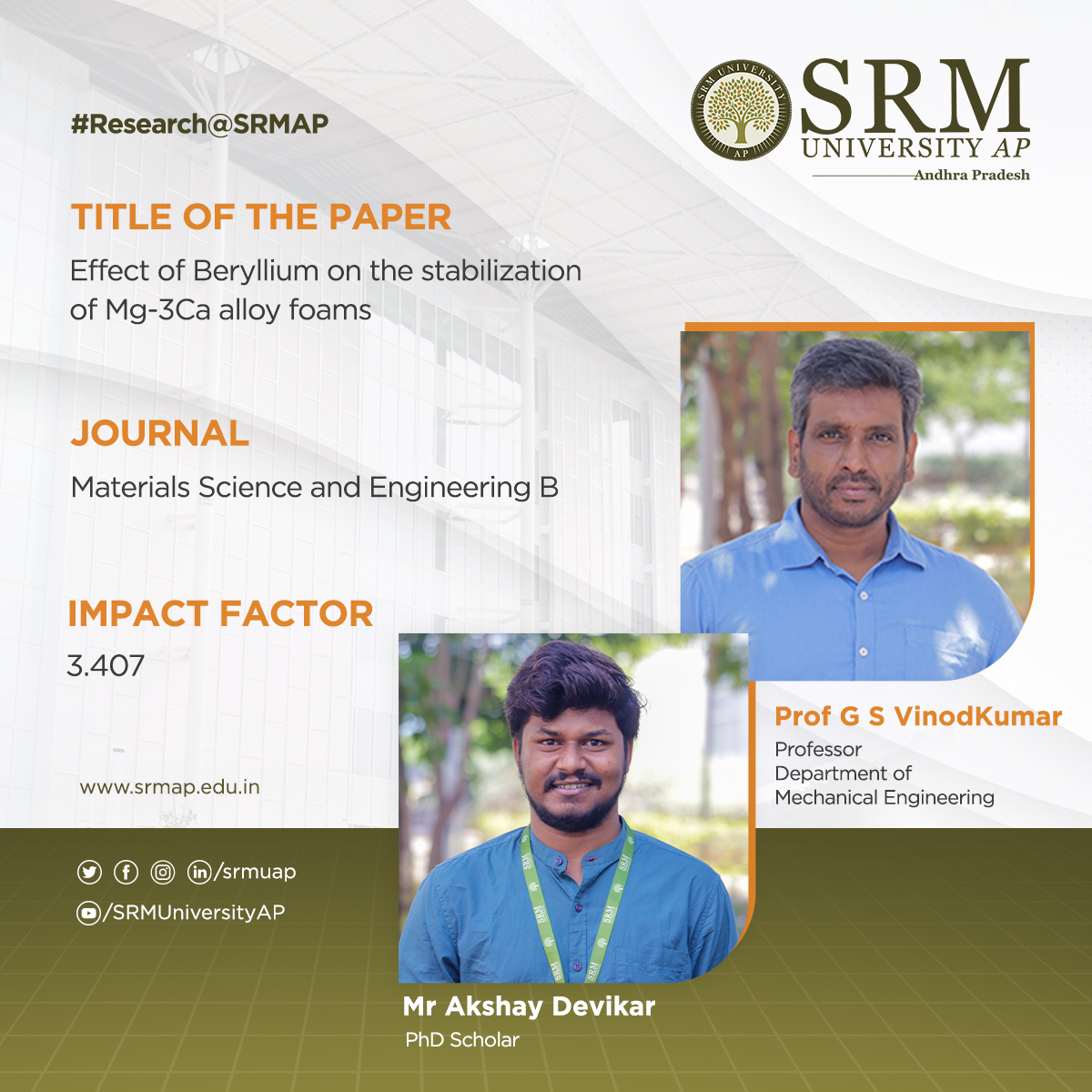 The second paper, the Effect of Beryllium on the stabilization of Mg-3Ca alloy foams, is published in the journal Materials Science and Engineering B with an impact factor of 3.407.
The second paper, the Effect of Beryllium on the stabilization of Mg-3Ca alloy foams, is published in the journal Materials Science and Engineering B with an impact factor of 3.407.Mg-3Ca alloy foams of density as low as 0.25 g/cm3 were successfully produced via the liquid metal route in an open-air atmosphere with trace Be addition. The stable BeO layer formed at the gas-solid interfaces of pores restricted the Mg + CO2/CO reaction, thereby reducing the gas loss responsible for foaming. Be addition (0.13 wt.%) resulted in a high-volume expansion of Mg-3Ca foam (694 %). Metallic single films also exhibited smooth and crack-free interfaces with Be addition.
Abstract
The present work is the first-ever study where the influence of beryllium (Be) addition on the stability of Mg alloy foam was investigated. Mg-3Ca alloy foams were produced by the liquid processing route with and without Be micro-addition. CaCO3 was used as a blowing agent. Mg-3Ca alloy foam without Be resulted in stable foam but exhibited low expansion with poor foam structure. Be addition significantly increased foam expansion and improved their structure. The expansion and the structure of the Mg foams obtained are comparable with that of commercially available aluminum foams. The XPS analysis confirmed the presence of BeO at the gas-solid interface of Mg foam. Be stabilizes the gas-solid interface of the foam by forming a smooth and crack-free surface of the BeO layer, which prevents the continuous oxidation of liquid foam and minimises the loss of blowing gas, thereby enhancing the stability of Mg-3Ca alloy foams.
Bulletproof vests, Car body parts, Hip and Knee implants, Sound and heat-proof walls in theatres, Naval ship bodies, etc., are some of the applications of the research findings. The researchers have collaborated with Dr Manas Mukherjee (Associate Professor) and his PhD student, Mr Biswaranjan Muduli of the Department of Metallurgical and Materials Engineering, Indian Institute of Technology Madras, Chennai, for this work. Stabilisation using other alloying elements and ceramic particles for improving mechanical properties of Mg foams specific to application requirements and establishing structure-property relationship from the point of view of melt viscosity by altering the foaming parameters are the future plans of the research team.
Continue reading → - SRM University- AP observes Research Day 5th Edition September 29, 2022
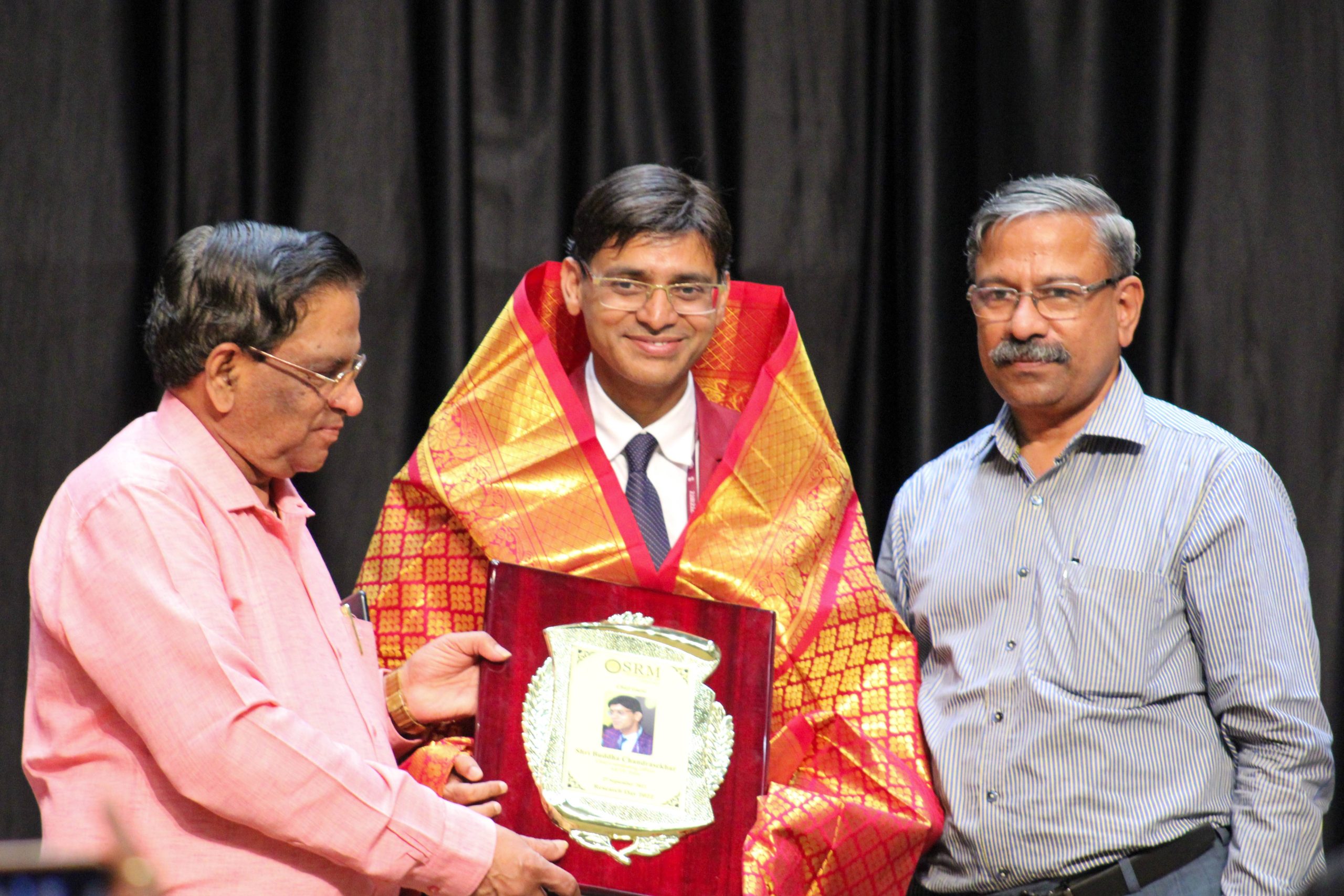 Research Day celebration at SRM University-AP continues to uplift the momentum of various research endeavors at the university and actuate the agenda of a research-oriented educational institution. The illustrious event held on Tuesday, September 27, 2022, fosters the exchange of information across disciplines, encourages extensive research projects, and appreciates innovative efforts in research. Dr Buddha Chandrasekhar, Chief Guest of the event, lauded the fundamental ideology of the initiative and highlighted the need to develop Indian students as world-class skilled workforce and entrepreneurs by providing real-time internship opportunities where industry and academy stay connected.
Research Day celebration at SRM University-AP continues to uplift the momentum of various research endeavors at the university and actuate the agenda of a research-oriented educational institution. The illustrious event held on Tuesday, September 27, 2022, fosters the exchange of information across disciplines, encourages extensive research projects, and appreciates innovative efforts in research. Dr Buddha Chandrasekhar, Chief Guest of the event, lauded the fundamental ideology of the initiative and highlighted the need to develop Indian students as world-class skilled workforce and entrepreneurs by providing real-time internship opportunities where industry and academy stay connected.Prof D Narayana Rao, Pro Vice-Chancellor, SRM AP, welcomed Dr Buddha Chandrasekhar, Chief Coordinating Officer, All India Council for Technical Education (AICTE), and other esteemed dignitaries. “Research and innovations are integral to growing and sustaining a large and vibrant society and economy. Innovations in science and technology are an integral part of the long-term growth and dynamism of any nation,” he stated and proceeded to elaborate how universities are proven as creators of new knowledge, innovative ideas, providers of skilled manpower, agents of social change, and symbols of international attention and research.
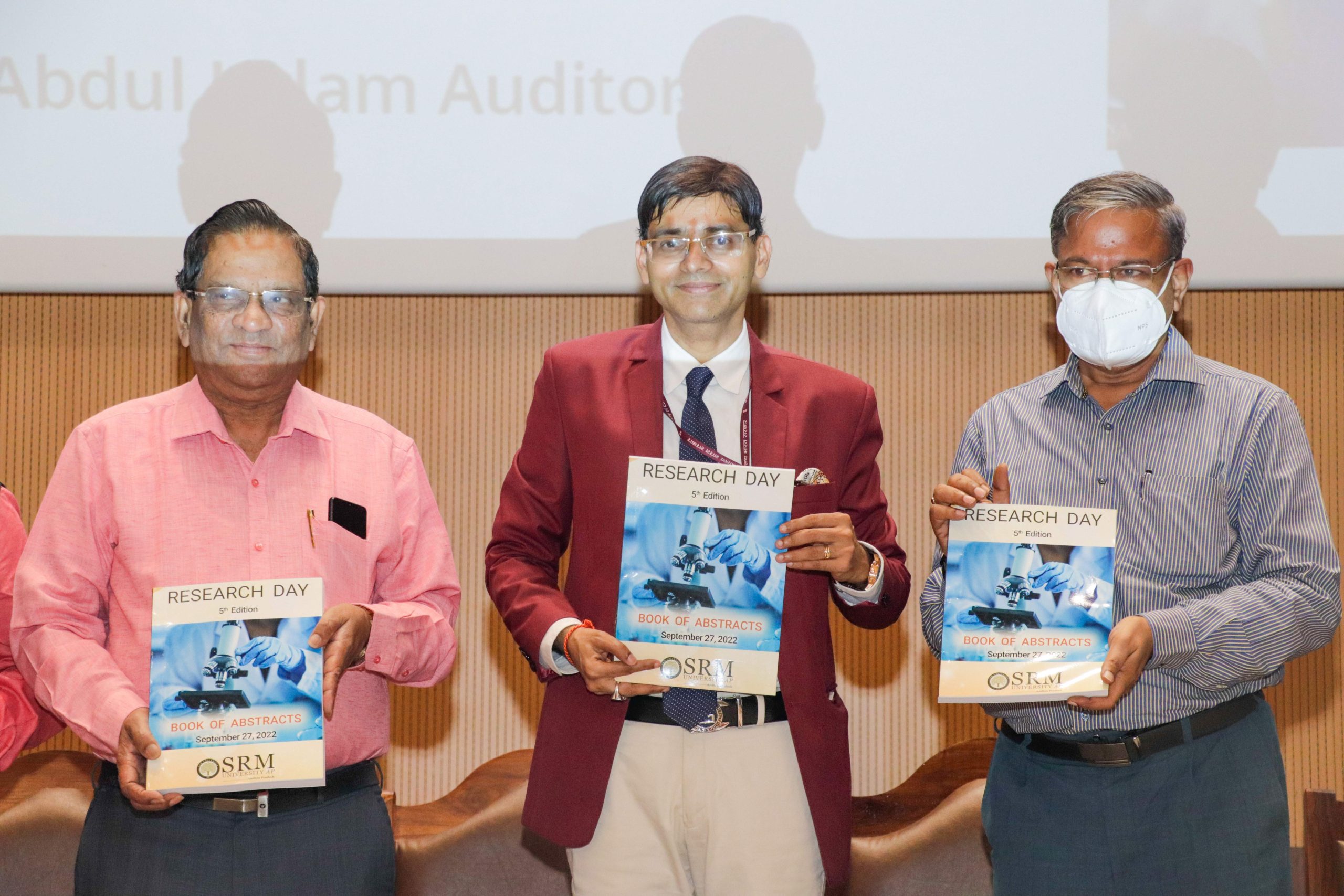 Dr Buddha Chandrasekhar shared his concerns regarding the widening gap between academy and industry and expressed his determination to reduce at least 5% unemployment in the country. He also demonstrated the websites 1crore aicte and aicte internship developed under the Ministry of Education and explained the arena of possibilities it opens to the youth of India.
Dr Buddha Chandrasekhar shared his concerns regarding the widening gap between academy and industry and expressed his determination to reduce at least 5% unemployment in the country. He also demonstrated the websites 1crore aicte and aicte internship developed under the Ministry of Education and explained the arena of possibilities it opens to the youth of India.As part of Research Day, students and faculty were advised to submit their research abstracts. A special issue of the research abstracts booklet comprised of all the selected abstracts was unveiled during the event. Gold medals and certificates have been awarded to qualified students and their mentors for their research work in various thematic areas. Dr Buddha Chandrasekhar displayed his enthusiasm to know further details of their research works and urged all the awardees to meet him in person after the event for a brief interaction.
Continue reading → - How to craft your first Research Paper! September 28, 2022
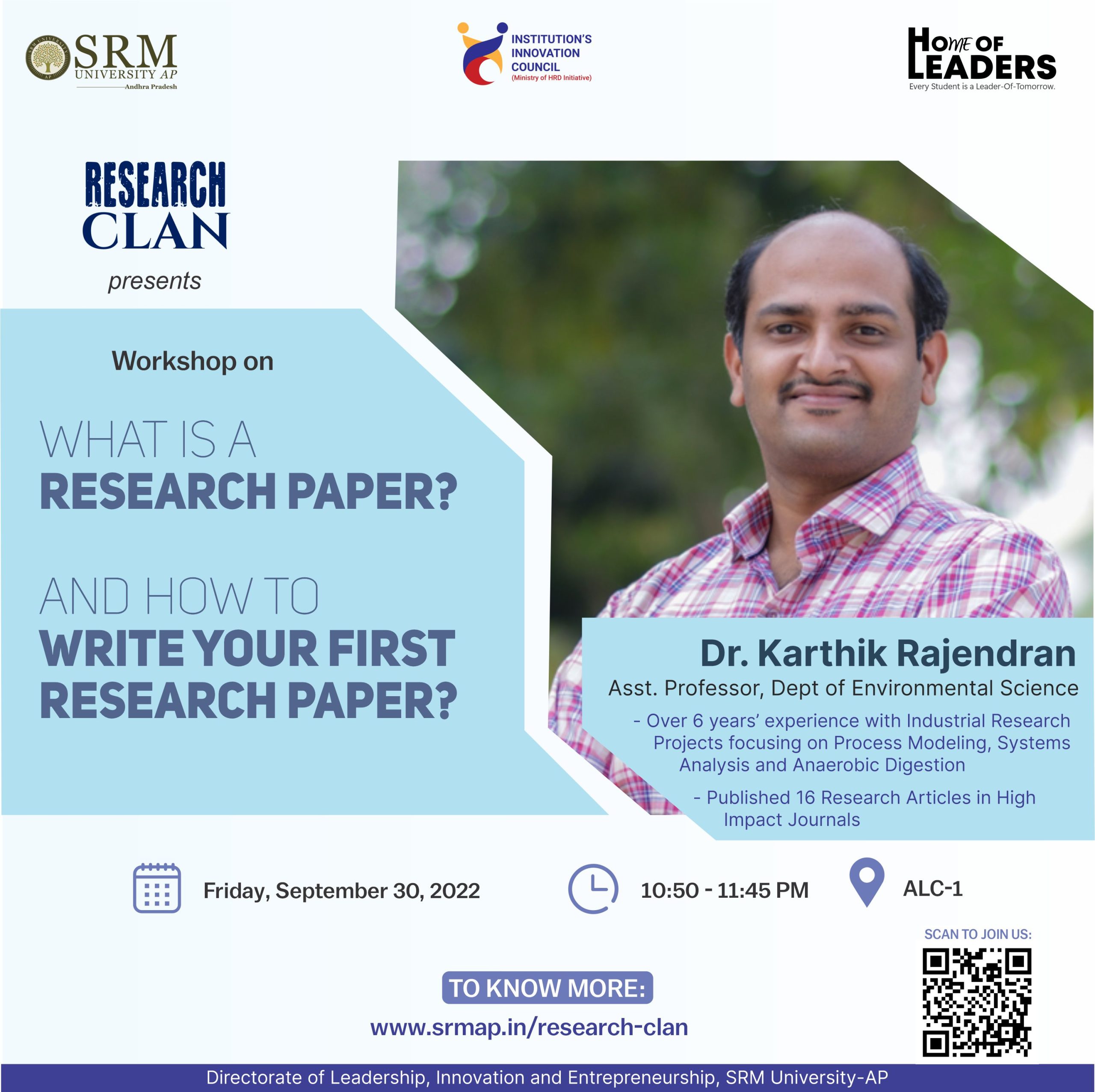 Propagating a novel finding to a general or focused audience requires an appropriate medium. Research papers serve this purpose by popularising your ideas and preventing them from duplication by a third party. They provide analysis, interpretation, and evaluation of anything and everything based on in-depth independent research. However, many research enthusiasts do not have a clear picture of how to craft a solid research paper. Research Clan, an initiative of the Department of Entrepreneurship and Innovation, is back with an exciting workshop on What is a research paper and how to write your first research paper. Dr Karthik Rajendran, Assistant Professor, Department of Environmental Science, will be guiding the students in writing an impactful research paper.
Propagating a novel finding to a general or focused audience requires an appropriate medium. Research papers serve this purpose by popularising your ideas and preventing them from duplication by a third party. They provide analysis, interpretation, and evaluation of anything and everything based on in-depth independent research. However, many research enthusiasts do not have a clear picture of how to craft a solid research paper. Research Clan, an initiative of the Department of Entrepreneurship and Innovation, is back with an exciting workshop on What is a research paper and how to write your first research paper. Dr Karthik Rajendran, Assistant Professor, Department of Environmental Science, will be guiding the students in writing an impactful research paper.Date: September 30, 2022
Time: 10.50 AM to 11.45 AM
Venue: ALC 1
About the speaker
Dr Karthik Rajendran has over 6 years of experience with industrial research projects focusing on Process Modelling, Systems Analysis, and Anaerobic Digestion. He has published several papers, book chapters, books, news articles, etc., in renowned Q1 journals and under various publishing houses. He has held various positions including the Editorial Board Member of Carbon Resources Conversion, Director of the Institute of Chartered Waste Managers, Outstanding reviewer of Energy, Conversion, and Management, etc.
A research paper is the first step on the journey to discovering something new. Join the workshop if you are willing to wander on this path of finding the unknown!
Continue reading → - Get set for the Global Immersion programmes September 28, 2022
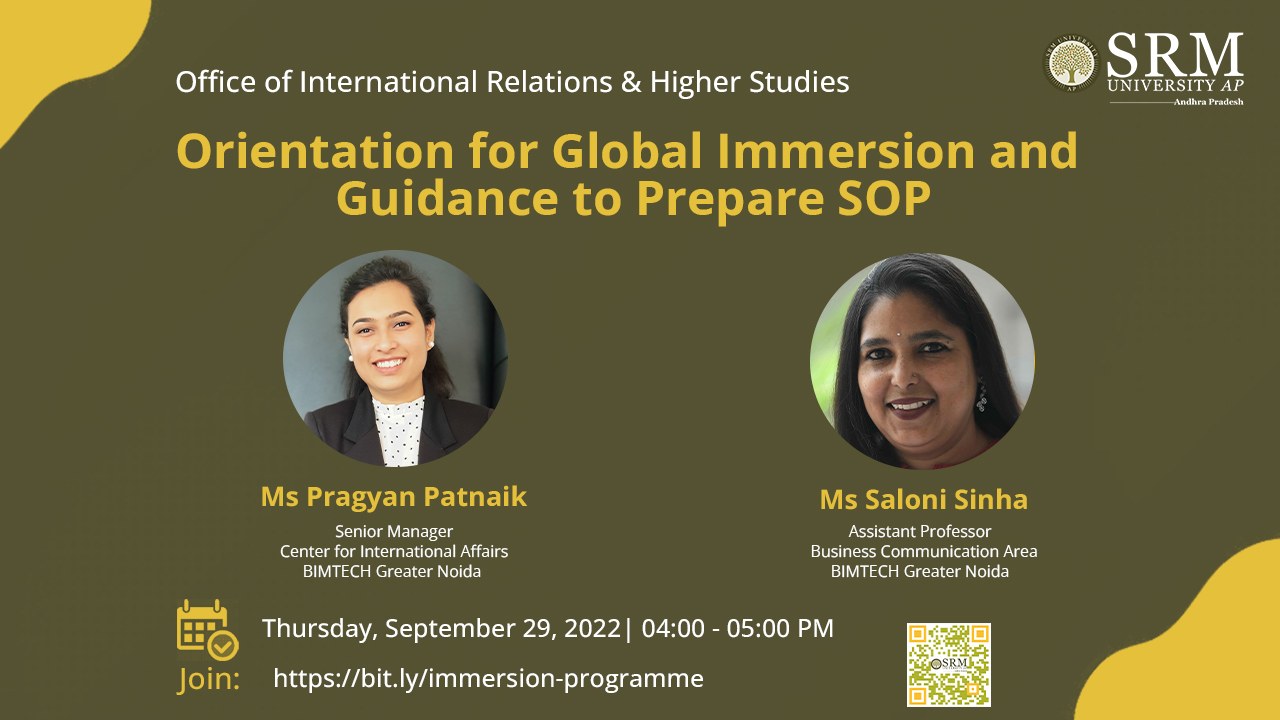
The Office of International Relations and Higher Studies is organising a session titled Orientation for Global Immersion and Guidance to Prepare SOP to enable students to lay the groundwork for their abroad learning programmes with a resounding Statement of Purpose. Ms Saloni Sinha and Ms Pragyan Patnaik from the Birla Institute of Management Technology will address the gathering.
Date: September 29, 2022
Time: 4.00 pm to 5.00 pm
A Statement of Purpose (SOP) is one of the most substantial pieces of evidence to facilitate your abroad learning. The clarity it exudes will define your needs and goals in pursuing the programme. Unfortunately, students are struggling to put together an SOP owing to their lack of clarity in drafting the document. This session intends to cast light on all the prerequisites for abroad education and will train students to compose a convincing SOP.
Speakers’ Profile
Ms Saloni Sinha is a faculty of Communication & Future Skills at the Birla Institute of Management Technology, India. She is a gold medallist in Linguistics from Jawaharlal Nehru University, New Delhi. She works in the domain of enhancing capabilities through her innovative teaching in the field of Communication, Theatre, Future skills, development communication and Intercultural Communication. Her research interests include employability skills, innovative classroom pedagogy, intercultural communication, corporate communication, development communication, education technology and translation. Ms Saloni has recently developed a novel SINHA’s COVID SEL 5X7 Matrix, a socio-emotional learning framework for educators. She is the recipient of the Youth Icon Award 2018 for her Theatre for Social Change initiatives. Ms Saloni is also empanelled as a casual translator in the Prime Minister’s Unit at the Press Information Bureau of the Government of India.
Ms Pragyan Patnaik takes an active interest in the Internationalisation of Higher Education Institutions. With more than a decade of international experience, her stint in the field began during her time as a Researcher in one of the leading Institutes of Technology in Germany – Leibniz University Hannover, in 2010. She has served in the field of Internationalisation of HEIs in various capacities in leading German universities, establishing academic and cultural bridges between India and Germany. She is the recipient of the prestigious Deutscher Akademischer Austauschdienst (DAAD) Fellowship, Germany. Prior to BIMTECH, she served with a premier Indian institution and was responsible for developing the University’s International Relations Office and leading international programs.
Continue reading → - Marquee offer of CTC 26.50 LPA: Srilekha entering a brand new arena of success September 28, 2022
 Addepalli Srilekha from the Department of Computer Science and Engineering is excited to step into a new phase of life with her incredible marquee offer of CTC 26.50. She is placed at Paypal, an American multinational fin-tech company that operates an online payments system that supports online money transfers. She is selected for the position of data scientist, where she will work for the Resolutions and Protections Team.
Addepalli Srilekha from the Department of Computer Science and Engineering is excited to step into a new phase of life with her incredible marquee offer of CTC 26.50. She is placed at Paypal, an American multinational fin-tech company that operates an online payments system that supports online money transfers. She is selected for the position of data scientist, where she will work for the Resolutions and Protections Team.She had the assistance of the Directorate of Corporate Relations and Career Services at every stage of her placement journey. Constant support and guidance were given to the students and different sessions were held in an organised manner which covered various aspects such as coding, interview handling skills, Resume building sessions, etc. One-on-one feedback sessions were also conducted by the placement panel, which was extremely helpful for the students.
Srilekha always wanted to work in data science, so she began her training with Python, SQL, Excel, and a few data visualisation courses. She has consistently learned all the fundamental concepts of computer science, such as data structures, operating systems, and database management systems. She also participated in Competitive Coding Contests from the beginning, which helped her develop an interest in coding and problem-solving. To learn the fundamental concepts, she used to refer to University materials and a few online resources. She has also done much hands-on coding and regularly applied the theoretical knowledge she gained.
The training received at SRM University- AP was highly relevant, timely, and beneficial for Srilekha. For students at various levels, various types of training were provided. “There is always the possibility of starting from scratch here. Daily technical assessments helped us understand the industrial standards and requirements”, said Srilekha as she recollected her training days. Company-specific tests were also administered, and regular alum connect sessions were organised to assist students in understanding the organisations’ recruitment and operations.
She is thankful to Dr Jatindra Kumar Dash, Dr Murali Krishna Enduri, and Dr Priyanka S for their excellent teaching, which was a great help for her during the placement season. “Dr Jatindra Kumar Dash greatly aided my understanding of Machine Learning Algorithms. Because of his guidance, I was able to answer every ML-related question in the interviews”, said Srilekha with gratitude. The classes she took helped enhance her subject knowledge and gain hands-on experience.
She studied FLAT and Compiler Design for two semesters under Dr Murali Krishna Enduri. This subject helped her understand the insights of Automata theory and the structural workings of compilers. These two subjects are Srilekha’s favorites solely because of Dr Murali Krishna Enduri. Dr Priyanka S taught her two crucial subjects that played a significant role in the placement season: Introduction to Python and Operating Systems. Her classes were very organised, and the teaching strategies were very effective.
Srilekha aspires to come up with new ideas and innovations at her workplace and climb up the ladder of her career with determination and hard work.
Continue reading → - Community training on Hands-Only CPR September 27, 2022
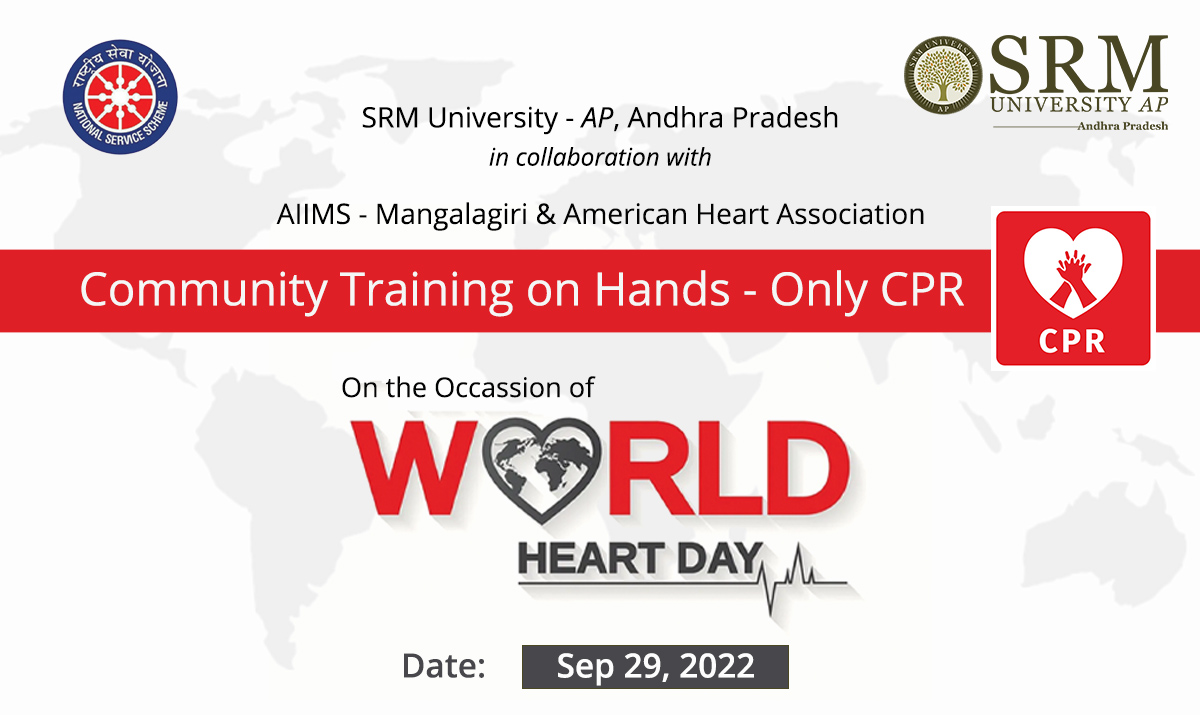
SRM University-AP, in collaboration with AIIMS Mangalagiri and the American Heart Association, is organising a Community Training on Hands-Only CPR on September 29, 2022, World Heart Day. Heart health is a fundamental human right and an essential component of global health justice.
World Heart Day was established by the World Heart Federation to educate people around the world that cardiovascular disease (CVD), including heart disease and stroke, is the leading cause of death in the world. The campaign highlights the actions that individuals can take to prevent and control CVD. It tries to motivate individuals to take action by educating them about how risk factors such as cigarette use, poor diet, and physical inactivity can prevent at least 80% of premature deaths from heart disease and stroke.
Cardiopulmonary Resuscitation (CPR) is an emergency lifesaving technique to be performed during instances of cardiac arrest or heart attack, or situations where someone’s heartbeat has stopped. CPR can double or triple the chances of survival after cardiac arrest. The American Heart Association is the leader in resuscitation science, education, and training and the publisher of the official Guidelines for CPR and ECC.
Learning Hands-Only CPR is learning an essential skill that would enable you to save a life!
Continue reading → - Career after engineering: a useful guide for your future September 26, 2022
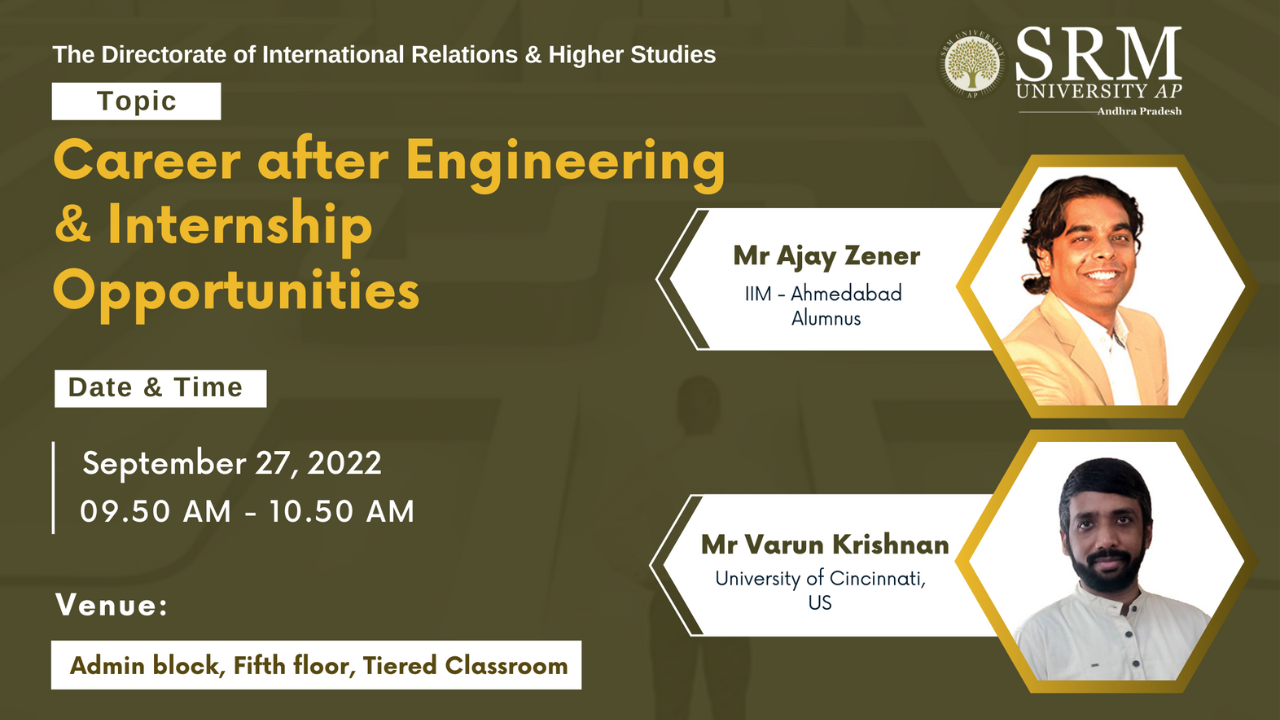 Engineering became a prominent career option over the past decades with the life-changing impacts it had on the common people’s world. It has a huge hand in making our lives easier with evolving technology and expanding innovations. The Directorate of International Relations and Higher Studies is hosting a seminar on Career after Engineering & Internship opportunities to discuss the possibilities of the disciplines in an elaborate manner. Renowned career mentor Mr Ajay Zener and SRM Alumni Mr Varun Krishnan will be interacting with the students.
Engineering became a prominent career option over the past decades with the life-changing impacts it had on the common people’s world. It has a huge hand in making our lives easier with evolving technology and expanding innovations. The Directorate of International Relations and Higher Studies is hosting a seminar on Career after Engineering & Internship opportunities to discuss the possibilities of the disciplines in an elaborate manner. Renowned career mentor Mr Ajay Zener and SRM Alumni Mr Varun Krishnan will be interacting with the students.Date: September 27, 2022
Time: 09.50 AM to 10.50 AM
Venue: Admin Block, Fifth Floor, Tiered classroom
About the speakers
Mr Ajay Zener is one of the best career mentors of India who has guided more than 10,000+ students the past 11 years to top universities across the world. He is an Engineering graduate from the National Dairy Research Institute, Karnal, with an MBA degree from IIM Ahmedabad. He has 13 years of work experience in international companies like Cadbury, Nestle and Olam and has worked in over 14 countries. He is working as CAT, GRE, and GMAT Mentor in GradSquare and has won the Brand Icon’s International Excellence Award for Best Career Counsellor in India 2022
Mr Varun Krishnan is an engineering graduate from SRM Institute of Science and Technology, Chennai, and a Mechanical Engineering graduate from the University of Cincinnati, US. He is currently mentoring the GRE, CAT & GMAT students. He handles Admission counseling for GMAT, GRE & GD-PI preparation for MBA students. He has secured 99.72% in CAT 2018, 99.62% in CAT 2019, and 99.78% in CAT 2021.
Join the seminar to get an in-depth understanding of the career opportunities after engineering!
Continue reading →

